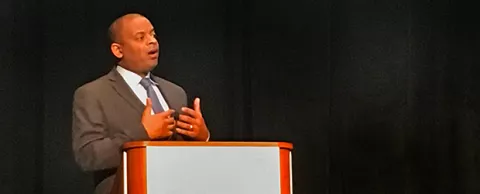
U.S. Transportation Secretary Anthony Foxx
There’s no question that transportation needs to change. Outdated infrastructure is falling apart and doesn’t have the capacity to handle future growth and changes in transportation preferences. Outdated funding models are not making the transformation easier.
But change can also provide tremendous opportunities. And U.S. Secretary of Transportation Anthony Foxx, speaking at the second-annual Smart Cities Week, says we are at the cusp of one of the biggest opportunities the country has ever had: the opportunity to shape new transportation systems to be inclusive from the start.
Foxx led a Smart City Challenge, an unprecedented $40 million grant offer to transform a city’s transportation system. Seventy-eight cities applied; Columbus, Ohio, won. And he said one of the reasons Columbus won is for how it’s using transit to address infant mortality. That’s right: infant mortality.
We explain below, but his message was clear. You can make a difference in the lives of all your citizens, but you must cut ties to outdated methods and think creatively and inclusively about your future. – Kevin Ebi
The roads we drive on today aren’t all that different from the roads our parents drove on a generation ago.
“We haven’t had a revolutionary idea for mobility in a half century,” said U.S. Secretary of Transportation Anthony Foxx, who said the interstate highway system was our last major advance.
Time to get revolutionary
Today’s world is a much different place. Millennials want to “buy rides,” not cars. As we seek to play an ever bigger role in the world economy, the amount of freight that needs to travel on our highway grows rapidly.
“As transportation planners, we should always be focused on the front windshield and not the rear view mirror,” Foxx urged the audience. “We cannot afford to be nostalgic about how we planned 50 years ago.”
New approach needed
Foxx says our funding models are as dated as the transportation infrastructure itself. He says we also need to move toward robust data and analytics.
“We need to build systems of data and analytics to track if what we thought was true is actually true, and use that data to drive our decision making,” he said. “Nostalgia is not a database.”
The Smart City Challenge itself represented a huge shift in approach. Foxx said in the old days, if his department had $40 million of funding to use for grants, the money would have been divided into dozens of small prizes. Offering a single jackpot, however, inspired 78 cities to work with a wide range of public and private stakeholders to develop solid, innovative plans.
While there was only one winner, there were no losers. That is because the application process triggered action plans and discussions that led to new investments.
“In a way, what the Smart City Challenge has done is spurred a billion dollars in new investment by turning cities attention to the future,” Foxx said.
What is truly smart?
Part of that new approach involves thinking about technology differently. Foxx says technology isn’t the end goal. The goal is helping people. Technology is the vehicle for doing that.
“When we talk about smart cities, what people typically talk about is the latest techy thing,” he said. “Smart cities are not collections of different technologies. Smart cities are cities that understand that those technologies are tools that connect to a larger plan.”
How Columbus won the prize
Columbus, Ohio, was the ultimate winner of the department’s Smart City Challenge and Foxx revealed a couple of elements of the city’s plan that set it apart. First, a key element of its plan involved improving the flow of freight. But second, and perhaps most importantly, it focused on using transportation to improve the lives of people who could really use help the most.
Foxx says most often, technology first benefits the people who have the most resources. They have the money to buy it and use it. As the technology becomes more ubiquitous, the cost of it drops and the benefits trickle down to people with fewer and fewer resources.
But unlike companies, cities aren’t constrained by that model. In fact, cities have the power to bring a wide range of socioeconomic groups together. And Columbus is an example of what’s possible.
Columbus has a problem with infant mortality that exacerbated by the challenges of mothers and children traveling to seek medical care. The city developed an integrated transit app that allows parents to make medical appointments and automatically plan transit trips to them. If there’s a transit delay, the app automatically reschedules the appointment. Payments are handled through the app too.
For those who don’t have smartphones, the city set up kiosks. And it’s now working on extending the payment capabilities for those who don’t have bank accounts.
“This is the first time in the history of our nation that we have an opportunity to build a transportation ecosystem that isn’t weighed down by exclusions, but that is driven by the idea of inclusion,” Foxx said. “And I think we can do it. It can be done when the creativity of our leaders is unleashed.”



